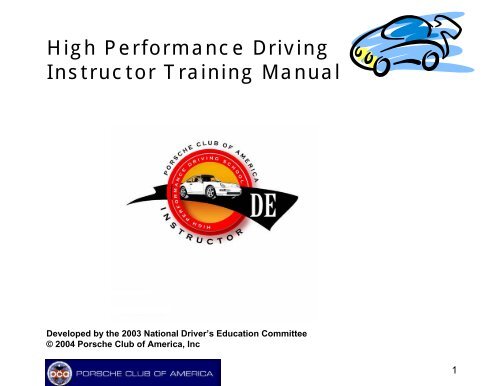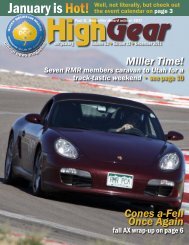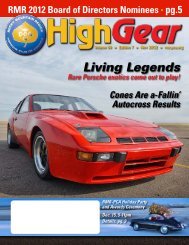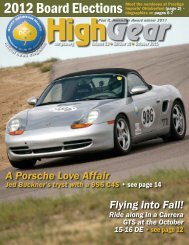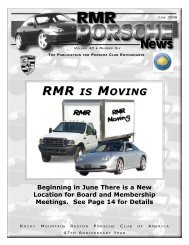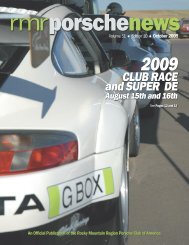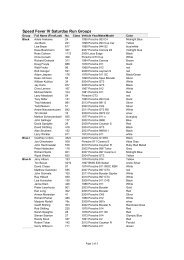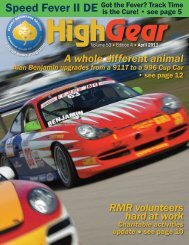High Performance Driving Instructor Training Manual - Rocky ...
High Performance Driving Instructor Training Manual - Rocky ...
High Performance Driving Instructor Training Manual - Rocky ...
Create successful ePaper yourself
Turn your PDF publications into a flip-book with our unique Google optimized e-Paper software.
<strong>High</strong> <strong>Performance</strong> <strong>Driving</strong><br />
<strong>Instructor</strong> <strong>Training</strong> <strong>Manual</strong><br />
Developed by the 2003 National Driver’s Education Committee<br />
© 2004 Porsche Club of America, Inc<br />
1
National Drivers’<br />
Education <strong>Instructor</strong><br />
<strong>Training</strong> Program<br />
• Orientation<br />
– The Why’s and What's of a National DE <strong>Instructor</strong> <strong>Training</strong> Program<br />
• Classroom Instruction<br />
– <strong>Instructor</strong> Attributes<br />
– Three Minute Interview<br />
– How to Teach<br />
– What to Teach<br />
– Debriefing and Critiquing<br />
• On Track <strong>Driving</strong> Sessions<br />
– Session One..Introduction<br />
– Session Two..Role playing<br />
– Session Three..Role Playing<br />
– Session Four..Check out<br />
• Be Safe<br />
• Learn<br />
• Have Fun<br />
2
Classroom Instruction<br />
“<strong>Instructor</strong> Attributes”<br />
• Positive Attitude<br />
– Always encourage<br />
students<br />
• “This is supposed to<br />
be fun”<br />
– Assist in the safety and<br />
success of event<br />
• “Be part of the<br />
solution, not the<br />
problem”<br />
– Leave the Ego at home<br />
• This is NOT racing<br />
3
Classroom Instruction<br />
“<strong>Instructor</strong> Attributes”<br />
• Professionalism<br />
– Use Discretion<br />
• In discussing students,<br />
exploits, other instructors<br />
– Cooperate with colleagues<br />
• Especially in handling<br />
“issues”, such as passing<br />
infractions, etc.<br />
– Use a communicator (helmet<br />
intercom)<br />
–Be on timeto your student(s)<br />
– Fill out evaluations forms/log<br />
books<br />
4
Classroom Instruction<br />
“<strong>Instructor</strong> Attributes”<br />
• Continuing Education<br />
– Keep current<br />
• Learn new teaching<br />
techniques and<br />
philosophies<br />
• Learn new cars and<br />
their characteristics<br />
• Learn Porsche<br />
models other than<br />
your own<br />
•Be Be Safe<br />
•Learn Learn<br />
•Have Have Fun<br />
5
Classroom Instruction<br />
“<strong>Instructor</strong> Attributes”<br />
• Continuing Education<br />
– Peer Mentoring<br />
• Take advantage of talents of<br />
other instructors<br />
– Continue to improve skills as<br />
driver and teacher<br />
– Ask for feedback from:<br />
• Your students, other<br />
instructors, the chief<br />
instructor, your evaluations<br />
– Remember to enjoy and learn<br />
from your students!<br />
•Be Be Safe<br />
•Learn Learn<br />
•Have Have Fun<br />
6
Classroom Instruction<br />
“Three Minute Interview”<br />
• The Most Important 3 to 5<br />
Minutes of the Day<br />
• Why have an interview at<br />
all?<br />
– Provides a formal<br />
meeting, one especially<br />
arranged for assessing<br />
the preparation and prior<br />
knowledge of the student<br />
– To provide instructors with<br />
a standardized starting<br />
point of instruction for<br />
every student<br />
7
Classroom Instruction<br />
“Three Minute Interview”<br />
• The Fastest Way to Gain<br />
Information is to:<br />
– ask pointed questions<br />
– get the student to talk about<br />
him or herself<br />
– create some humor, it<br />
relaxes people<br />
– show interest in the car, you<br />
need to know the car’s setup<br />
and characteristics<br />
Listening is crucial; it<br />
requires your full attention<br />
8
Classroom Instruction<br />
“Three Minute Interview”<br />
• Gain Insight into Your<br />
Student’s:<br />
– attitude: eager, scared,<br />
know-it-all, or clueless<br />
– motives: have fun, drive<br />
better, club race, etc<br />
– capabilities: autocross, track<br />
experience, involved in sports<br />
such as skiing<br />
– preparation: looked at track<br />
map, reviewed track guide,<br />
knows the meaning of the<br />
flags<br />
9
Classroom Instruction<br />
“Three Minute Interview”<br />
• Interpreting Student Responses<br />
– What is the current mental state of your<br />
student<br />
• tired? alert? anticipatory?<br />
– How does this person learn?<br />
• Is s/he a visual or auditory learner?<br />
A combination of both?<br />
• Use cues from his/her answers to<br />
plan your teaching strategy<br />
•Be Be Safe<br />
•Learn Learn<br />
•Have Have Fun<br />
10
Classroom Instruction<br />
“Three Minute Interview”<br />
• Formulate a Starting<br />
Point for Instruction<br />
– Use the answers to your<br />
questions to plan a<br />
strategy to instruct this<br />
student<br />
– Do you need more<br />
information?<br />
– Do you have a fall-back<br />
plan?<br />
11
Classroom Instruction<br />
“Three Minute Interview”<br />
• The four parts of the<br />
interview<br />
– Social<br />
– Technical<br />
– Safety<br />
– Directive<br />
•Be Be Safe<br />
•Learn Learn<br />
•Have Have Fun<br />
12
Classroom Instruction<br />
“Three Minute Interview”<br />
• Social<br />
– What do you do in real life?<br />
– Is this your car?<br />
– How long have you been driving it?<br />
– Do you know anyone else at the<br />
event?<br />
– How are you feeling?<br />
•Be Be Safe<br />
•Learn Learn<br />
•Have Have Fun<br />
13
Classroom Instruction<br />
“Three Minute Interview”<br />
• Technical<br />
– Do you have any previous<br />
high-speed driving<br />
experience?<br />
– What sort of changes<br />
have you made to the<br />
car?<br />
– What kind of tires?<br />
– Do you do your own<br />
work?<br />
14
Classroom Instruction<br />
“Three Minute Interview”<br />
• Safety<br />
– Do you remember where<br />
the passing zones are?<br />
– Do you know where the<br />
corner stations are?<br />
– Should we review the<br />
flags?<br />
– Did you drive in yesterday<br />
or this morning?<br />
– Are you tired, or ready to<br />
go?<br />
– Review emergency<br />
procedures<br />
15
Classroom Instruction<br />
“Three Minute Interview”<br />
• Directive<br />
– Setting the tone for the<br />
instructional process<br />
– Words or phrases, with hand<br />
signals<br />
• Brake<br />
• Accelerate/Lift<br />
• Track right/Track left<br />
• Turn in now<br />
• Unwind<br />
• Smooth<br />
• Apex<br />
• Shift<br />
16
Classroom Instruction<br />
“Three Minute Interview”<br />
• Goals<br />
– “We are going to concentrate on”<br />
• Vision (looking ahead) (eyes in<br />
front of the car)<br />
• The line (turn-in, apex, track-out)<br />
• Braking<br />
• Being smooth<br />
• Specifics for this individual’s<br />
needs<br />
•Be Be Safe<br />
•Learn Learn<br />
•Have Have Fun<br />
17
Classroom Instruction<br />
“Three Minute Interview”<br />
• <strong>Instructor</strong> Checklist<br />
– Safety items<br />
– Goals<br />
– Vocabulary<br />
– <strong>Driving</strong> position<br />
– Car<br />
– Let’s go have some fun!<br />
18
Classroom Instruction<br />
“Three Minute Interview”<br />
• End of Session One…<br />
Three Minute Interview<br />
• Questions?<br />
19
Scenario One<br />
FIRST RIDE<br />
Mentor Role: To model good teaching technique and the language of<br />
instructing.The ride becomes the standard that the candidate will practice<br />
towards in the next two rides. The mentor will drive and demonstrate the<br />
following:<br />
1. The “three minute” interview (before entering the car).<br />
2. “Staging orientation” where proper seat and hand positions<br />
are discussed as well as emergency procedures, hand signals, etc.<br />
3. “Two-lap orientation” ride in which all flag stations, run-off areas<br />
and general track layout are discussed.<br />
4. After the two-lap orientation, the mentor, still from the left<br />
seat, will demonstrate the methods of instruction that will be<br />
discussed in the classroom, including; for example, proper use of<br />
vision, teaching the line, general car placement and control, mirrors<br />
and passing, etc.<br />
5. After the session ends, the mentor will model critiquing and goal<br />
setting in a debrief.<br />
20
Classroom Instruction<br />
“ How to Teach”<br />
• Session Two …..<br />
How to Teach<br />
– How Adults Learn<br />
– Methods and Skills of<br />
Teaching<br />
21
Classroom Instruction<br />
“How to Teach” – Adult Learners<br />
• Theory of Learning – “How People Learn”<br />
– Levels of Learning<br />
– Laws of Learning<br />
– Learning Process<br />
– Learning Curve<br />
– Learning Styles<br />
– Barriers to Learning<br />
•Be Be Safe<br />
•Learn Learn<br />
•Have Have Fun<br />
22
Classroom Instruction<br />
“How to Teach” – Adult Learners<br />
• Levels of Learning<br />
– Unconscious Incompetent: Novice<br />
– Conscious Incompetent: Enlightened Novice<br />
– Conscious Competent: Beginner/Intermediate<br />
– Unconscious Competent: Advanced<br />
23
Classroom Instruction<br />
“How to Teach” – Adult Learners<br />
Thorndike’s Laws of Learning<br />
1. Readiness – motivation, clear objectives &<br />
strong purpose<br />
2. Exercise – repetition, practice<br />
3. Effect – fun factor strengthens learning<br />
4. Primacy – Teach correctness..bad habits<br />
learned early are hard to break<br />
5. Intensity – vivid experiences teach best<br />
6. Recency – most recent, best remembered<br />
24
Classroom Instruction<br />
“How to Teach” – Adult Learners<br />
• Learning Process –<br />
circular in four steps<br />
– Have an experience<br />
– Reflect on that experience<br />
– Develop ideas and<br />
conclusions<br />
– Test conclusions<br />
– Have an experience<br />
Test<br />
Conclusions<br />
Have an<br />
experience<br />
Develop Ideas<br />
and<br />
Conclusions<br />
Reflect on that<br />
experience<br />
25
Classroom Instruction<br />
“How to Teach” – Adult Learners<br />
• Learning Curve<br />
– Rapid early improvement<br />
– Plateau (normal)<br />
– Regression (the<br />
intermediate’s downfall)<br />
26
Classroom Instruction<br />
“How to Teach” – Adult Learners<br />
• Learning Styles<br />
Each person is a unique<br />
combination of these styles, with<br />
one generally dominant.<br />
Each instructor tends to teach in<br />
their primary learning style<br />
1. Learns by doing<br />
2. Learns by thinking and<br />
understanding<br />
3. Learns by experiencing<br />
“the process”<br />
4. Learns by watching and<br />
listening<br />
27
Classroom Instruction<br />
“How to Teach” – Adult Learners<br />
• Barriers to Learning<br />
1. Fear – of the unknown, of failure, of<br />
physical harm, and of showing fear itself<br />
2. Self-Concept<br />
3. Defense Mechanisms<br />
– Rationalization (justification)<br />
– Flight (excuses for failure)<br />
– Aggression(complaining)<br />
– Resignation (gives up)<br />
4. Stress and Anxiety<br />
5. Impatience and Overconfidence<br />
•Be Be Safe<br />
•Learn Learn<br />
•Have Have Fun<br />
28
Classroom Instruction<br />
“How to Teach – Methods and Skills”<br />
• Methods and Skills of the<br />
Successful <strong>Instructor</strong><br />
– Vision<br />
– Demonstration Drive<br />
– Communication<br />
– Situational Control<br />
29
Classroom Instruction<br />
“How to Teach – Methods and Skills”<br />
• Vision<br />
– The most important tool in<br />
your toolbox<br />
“Students think they<br />
come to the track<br />
already knowing how<br />
to drive, and how to<br />
see…”<br />
“Progress from point to<br />
point driving to a<br />
smooth curve….”<br />
30
Classroom Instruction<br />
“How to Teach – Methods and Skills”<br />
• Vision – novices tend to:<br />
– look down at pavement in<br />
front of car<br />
– follow the car in front of them<br />
– make directional corrections<br />
in turns<br />
– Drive point-to-point (cone-tocone)<br />
– See only the “road”, not<br />
flaggers, etc<br />
All symptomatic of not looking<br />
far enough ahead<br />
31
Classroom Instruction<br />
“How to Teach – Methods and Skills”<br />
• Vision - how it works<br />
• At 100 mph, you travel 150 feet per second<br />
– One second out: 150 feet is history (no reaction time) = fear<br />
(foot lifts)<br />
• Brain overload, the eyes fixate, muscles tense<br />
– Two seconds out: 300 feet allows time to react = anxiety<br />
• Judgment oscillates, the eyes dart, inputs are harsh<br />
– Three seconds out: 450 feet (to horizon) gives time to act =<br />
comfort (on the throttle)<br />
• Proactive thinking, eyes lead car, muscles relax, smooth<br />
inputs<br />
32
Classroom Instruction<br />
“How to Teach – Methods and Skills”<br />
• Demonstration Drive Benefits<br />
– Visual learners – “picture worth a thousand words”<br />
• SHOW line, technique, etc<br />
– See what the car is capable of<br />
• “you mean the car can really do that?”<br />
– Student can see, hear, and feel more when not<br />
concentrating on driving at the same time<br />
• Ask them to observe your inputs, the gauges, and<br />
listen to the car<br />
– Student sees high speed driving done right<br />
• Drive your best, and explain any errors<br />
– Student can ask questions in real time<br />
33
Classroom Instruction<br />
“How to Teach – Methods and Skills”<br />
• Demonstration Drive Risks<br />
– May scare student<br />
– May excite student<br />
– May overdrive their ability<br />
afterwards<br />
• Always caution student<br />
that this may happen<br />
• “Do as I say, not as I<br />
do!”<br />
34
Classroom Instruction<br />
“How to Teach – Methods and Skills”<br />
• Communication is a Two-<br />
Way Street<br />
– Listen and observe just as<br />
much as you talk<br />
• We tend naturally to<br />
teach in our own learning<br />
style<br />
• Ask if you are talking too<br />
much, or not enough<br />
• Save long explanations<br />
for the pits, not at speed<br />
35
Classroom Instruction<br />
“How to Teach – Methods and Skills”<br />
• Communication is a Two-Way<br />
Street<br />
– Ask questions:<br />
• Elicit what student is<br />
thinking, feeling, doing<br />
• “Do you like things<br />
explained? To read about<br />
it? To see it demonstrated?<br />
To just “do it”?”<br />
– As an instructor, “Are you really<br />
listening, or just waiting to talk?”<br />
– Watch the student - observe<br />
36
Classroom Instruction<br />
“How to Teach – Methods and Skills”<br />
• Non-Verbal<br />
– Hand signals – fist up<br />
(brake), point left/right,<br />
hand forward (throttle<br />
on)<br />
– Body Language – a<br />
foot on an invisible brake<br />
or a death grip on door<br />
handle is a give-away<br />
37
Classroom Instruction<br />
“How to Teach – Methods and Skills”<br />
• Praise<br />
– Your most important tool<br />
• Praise immediately to<br />
reinforce the correct<br />
behavior<br />
• “Good job with your<br />
mirrors”, “Nice<br />
downshift”<br />
– Avoid negativism, instead<br />
be encouraging<br />
• “You’ll get it next lap”,<br />
“Let’s turn in a little<br />
later”<br />
38
Classroom Instruction<br />
“How to Teach – Methods and Skills”<br />
• Comfort Zone<br />
– Yours<br />
• Be in it, let the Chief<br />
<strong>Instructor</strong> know what<br />
makes you uncomfortable<br />
– Theirs<br />
• Observe student, and<br />
assess it – don’t push<br />
beyond, and also don’t<br />
hold back when they are<br />
ready to move forward<br />
•Be Be Safe<br />
•Learn Learn<br />
•Have Have Fun<br />
39
Classroom Instruction<br />
“How to Teach – Methods and Skills”<br />
• <strong>Instructor</strong> - Student Roles<br />
– YOU are in control<br />
• “Perception is Reality”, display<br />
confidence<br />
• You have authority through<br />
your position as instructor<br />
• Allow your CI to give you<br />
guidance if required<br />
• If you are a rookie instructor,<br />
or have never been to this<br />
track, it is not necessary to<br />
“confess”<br />
40
Classroom Instruction<br />
“How to Teach – Methods and Skills”<br />
• <strong>Instructor</strong> - Student Roles<br />
– Be approachable<br />
• Most students by nature<br />
will want your approval and<br />
to follow your instructions –<br />
let them!<br />
– Be directive<br />
• “Let’s stay under 70 mph<br />
during the first two warm<br />
up laps to concentrate on<br />
the line”, “downshift only at<br />
turn 2 and stay in 3 rd gear<br />
for the rest of the track”<br />
41
Classroom Instruction<br />
“How to Teach – Methods and Skills”<br />
• In a Situation<br />
– Use calm, clear, firm tone of<br />
voice<br />
– Direct driver clearly – “Brake,<br />
brake hard, harder”<br />
• Don’t just watch it<br />
happen…<br />
• Do not grab the wheel -<br />
unless disaster is truly<br />
imminent<br />
– Pit in after incident & analyze<br />
what went wrong<br />
42
Classroom Instruction<br />
“ How to Teach”<br />
• End of Session Two…<br />
How to Teach<br />
• Questions<br />
43
Scenario Two<br />
SECOND RIDE<br />
Candidate’s Role: The Candidate instructs the entire session. The scenario will<br />
mimic a standard ”first ride” for a novice student which would include:<br />
1. “Three Minute” interview<br />
2. “Staging” interview which will include seat and hand position and<br />
general safety concerns.<br />
3. Two lap orientation ride (as determined by regional practices)<br />
4. After the orientation ride, the candidate will enter the pits and switch<br />
seats as per a normal novice orientation. (if appropriate)<br />
5. The candidate will then instruct from the right hand seat for the<br />
remainder of this session and the entire third session.<br />
Mentor’s Role: The mentor will behave as a first time novice student. S/he will<br />
observe the interview and staging procedures and follow the instruction from<br />
the candidate instructor. This is a teaching exercise where the mentor’s<br />
function is to “coach” the candidate instructor. This will mean that the mentor<br />
comes out of role-playing to stress or correct a certain point or procedure. The<br />
terms “time-out” and “time-in” are convenient to go in and out of role.<br />
44
Classroom Instruction<br />
What to Teach<br />
• Session Three…<br />
What to Teach<br />
– Novice<br />
– Beginner<br />
45
Classroom Instruction<br />
“What to Teach”<br />
Novice Benchmarks:<br />
(Skills required before promotion from Novice to Beginner)<br />
• Drives the line accurately and consistently.<br />
• Drives at an appropriate pace for the group.<br />
• Inputs increasingly smooth.<br />
• Makes few mistakes and self corrects.<br />
• Calm in traffic.<br />
• Anticipates slower cars in front.<br />
• Does not “tailgate”.<br />
• Does not give or accept late passing signals.<br />
• Gives passing signals promptly.<br />
• Passes with good safety margins.<br />
• Exhibits good manners and consideration.<br />
• Displays full knowledge of procedures, flags and driving terminology.<br />
• Is safe to drive alone (even if not yet signed off).<br />
46
Classroom Instruction<br />
“What to Teach”<br />
Novice<br />
• Track Protocol and<br />
Safety<br />
– Staging, review driving<br />
position, etc<br />
– Pit-Out/ Pit-In Procedures<br />
– Flag Meaning and Action<br />
– Safety / Emergencies<br />
• Recognize and React<br />
– Warm Up and Cool Down<br />
Laps<br />
47
Classroom Instruction<br />
“What to Teach”<br />
Novice<br />
• <strong>Driving</strong> “the Line”<br />
– Turn-in<br />
– Apex<br />
– Track-out<br />
– Between Turns<br />
48
Classroom Instruction<br />
“What to Teach”<br />
Novice<br />
• Operating the Car<br />
– Steering<br />
• Hand Position and<br />
Movement<br />
– Accelerating<br />
• Smooth Throttle Control<br />
– Shifting<br />
• Up and Down, Timing<br />
– Braking<br />
• Timing, Smoothness<br />
49
Classroom Instruction<br />
“What to Teach”<br />
Novice<br />
• Skills and Techniques<br />
– Vision<br />
• Up and Out, Reference<br />
Points<br />
– Car Control<br />
• Recognition and<br />
Reaction to Understeer<br />
and Oversteer<br />
– Passing<br />
• Too soon, too late,<br />
where and how<br />
– Smoothness and Balance<br />
– Consistency and Accuracy<br />
50
Classroom Instruction<br />
Common Student Errors<br />
•Indecisive use of controls<br />
•Jerky, abrupt inputs<br />
•Early apexes<br />
•Creeping in before initiating the turn<br />
•Failure to let the car track out/Pinching the exit of<br />
the turn<br />
•Turning in before releasing the clutch and /or brake<br />
pedal<br />
•Inability to judge braking distances and effort<br />
•Inconsistency as speeds increase<br />
•Overly concerned with “lap times”<br />
•Traffic issues..worry about holding others up or not<br />
being able to pass<br />
•Mirrors..not checking or overly obsessed and not<br />
looking in front<br />
51
Classroom Instruction<br />
“What to Teach”<br />
Beginner Benchmarks:<br />
(Skills required before being signed-off to Intermediate (non-student)<br />
status)<br />
• Uses the full track consistently.<br />
• Very smooth inputs, especially braking.<br />
• Uses Ocular Vision in most corners.<br />
• Carries reasonable momentum into corners.<br />
• Practices effective heel and toe braking/downshifting.<br />
• Demonstrates competent car control and recovery skills.<br />
• Prompt and courteous passing signals.<br />
• Good driving record for two events minimum.<br />
• Calmly deals with fast traffic and close passing.<br />
• Demonstrates full compliance with Region DE philosophy.<br />
52
Classroom Instruction<br />
“What to Teach”<br />
Beginner<br />
• Operating the Car<br />
– Steering<br />
• Hand Position and<br />
Movement<br />
– Accelerating<br />
• Throttle Steer<br />
– Shifting<br />
• Timing, Heel and Toe<br />
– Braking<br />
• Threshold, Transition,<br />
Smoothness<br />
53
Classroom Instruction<br />
“What to Teach”<br />
Beginner<br />
• Skills and Techniques<br />
– Vision<br />
• Increasing Awareness<br />
– Car Control<br />
• Managing the contact patch<br />
– Passing<br />
• Handling close traffic & off-line turns<br />
– Smoothness and Balance<br />
– Consistency and Accuracy<br />
54
Classroom Instruction<br />
“What to Teach”<br />
• Vision - favorite maxims<br />
– The car goes where you look<br />
– You can only drive as fast as you can think<br />
– Turn your head, point your nose<br />
– The hands follow the eyes<br />
– The future is more important than the past<br />
– The future is closer than you think!<br />
“Everything a person does is created twice, once in the<br />
mind, once in the execution.”<br />
55
Classroom Instruction<br />
“What to Teach”<br />
• Vision<br />
– Scan, don’t fixate<br />
– Look 3 seconds ahead<br />
– Trust and use peripheral<br />
vision<br />
– Look past or around car in<br />
front of you<br />
– Three mistakes in a row:<br />
slow down, re-focus<br />
• These concepts are introduced to the novice, reinforced<br />
to the beginner, and second nature before sign-off.<br />
56
Classroom Instruction<br />
“What to Teach”<br />
• Mental Preparedness<br />
– Judgment is a skill developed with seat<br />
time<br />
– Situational Awareness<br />
– Planning-anticipation<br />
– Concentration<br />
– Aggressiveness<br />
– Courtesy<br />
– Self Analysis<br />
– Receptiveness to Learning<br />
– Decision Making - product of experience<br />
•Be Be Safe<br />
•Learn Learn<br />
•Have Have Fun<br />
57
Classroom Instruction<br />
“What to Teach”<br />
• End of Session Three…<br />
What to Teach<br />
• Questions<br />
58
Scenario Three<br />
THIRD RIDE<br />
Candidate’s Role: The candidate will continue to instruct the “novice<br />
student” from the right seat. The student is improving through your<br />
instruction so you will also need to use techniques and tools<br />
appropriate for an advanced beginner student.<br />
Mentor’s Role: The mentor will continue to drive the car as a novice<br />
student, but with proper instruction you have now improved to the<br />
beginner status and will drive accordingly. You are still a coach<br />
and will come out of role playing as needed to stress a point,<br />
model a technique, etc. By the end of this session, the candidate<br />
ideally should be fully prepared for a check out ride. If the<br />
candidate needs more work, the mentoring will continue for the<br />
fourth session instead of a check-out ride.<br />
59
Classroom Instruction<br />
“Debriefing & Critiquing”<br />
• Session Four…<br />
Debriefing & Critiquing<br />
•Be Be Safe<br />
•Learn Learn<br />
•Have Have Fun<br />
60
Classroom Instruction<br />
“Debriefing and Critiquing”<br />
• Definition of Critique<br />
– Webster: To discuss<br />
and/or consider the merits<br />
and demerits of a<br />
performance and judge<br />
accordingly.<br />
• Purpose of the Critique<br />
– No instructor’s skill is<br />
more important than the<br />
ability to analyze,<br />
appraise, judge, and<br />
correct a student’s<br />
performance.<br />
61
Classroom Instruction<br />
“Debriefing and Critiquing”<br />
• Qualities of a Critique<br />
– Compare with others of<br />
the same experience level<br />
– Be Objective<br />
– Be Acceptable<br />
– Be Constructive<br />
– Be Comprehensive<br />
– Be Thoughtful<br />
– Be Specific<br />
– Be Timely<br />
– Be Positive<br />
•Be Be Safe<br />
•Learn Learn<br />
•Have Have Fun<br />
62
Classroom Instruction<br />
“Debriefing and Critiquing”<br />
• Critique Process<br />
– Oral Quizzing<br />
– Analyze data for student<br />
evaluation in four areas:<br />
knowledge<br />
skill<br />
proficiency<br />
judgment<br />
– Goal Setting<br />
•Be Be Safe<br />
•Learn Learn<br />
•Have Have Fun<br />
63
Classroom Instruction<br />
“Debriefing and Critiquing”<br />
• Oral Quizzing<br />
– Questioning Skills<br />
• Effective questions should<br />
elicit specific responses<br />
• Keep questions brief, but<br />
challenging<br />
• Ask “why”, “how” and<br />
“where” questions<br />
•Be Be Safe<br />
•Learn Learn<br />
•Have Have Fun<br />
64
Classroom Instruction<br />
“Debriefing and Critiquing”<br />
Analyze Data for Student Evaluation<br />
• Knowledge<br />
• Skill<br />
– Safety<br />
– Pit Procedures<br />
– Flags<br />
– <strong>Driving</strong> Line<br />
– Passing..signals and areas<br />
– Emergencies<br />
– Vision<br />
– Car Control<br />
•Be Be Safe<br />
•Learn Learn<br />
•Have Have Fun<br />
65
Classroom Instruction<br />
“Debriefing and Critiquing”<br />
Analyze Data for Student<br />
Evaluation<br />
• Proficiency<br />
– Track Awareness<br />
– Smoothness<br />
– Consistency<br />
• Judgment<br />
– Self Analysis<br />
– Courtesy<br />
– Aggressiveness<br />
66
Classroom Instruction<br />
“Debriefing and Critiquing”<br />
• Goal Setting<br />
– Collaboratively set goal(s)<br />
for each training session<br />
and identify obstacles to<br />
learning<br />
– Re-evaluate goals after<br />
each training session<br />
• What went well…<br />
• What needs work...<br />
67
Classroom Instruction<br />
“Debriefing & Critiquing”<br />
• End of Session Four…<br />
Debriefing & Critiquing<br />
• Questions<br />
68
Check-Out Session<br />
Candidate’s Role: The candidate instructor will run through the entire<br />
scenario with the check-out mentor as if the mentor is a first time<br />
novice student, including the “three minute” interview, “staging” talk<br />
and the two lap orientation, which will be done from the right seat to<br />
save time. After the “two lap orientation ride”, the candidate will then<br />
proceed to instruct as if the mentor is a novice student.<br />
Mentor’s Role : The mentor will act as a new student, but will drive the<br />
car for the entire session. He/she will exhibit normal novice errors<br />
but will take “instruction” from the instructor candidate and should<br />
progress to an advanced beginner by the end of the session.<br />
End of Session..The mentor will orally “debrief” with the instructor<br />
candidate. The mentor will then fill out the evaluation form and return<br />
it to the Classroom <strong>Instructor</strong>. Do not discuss this evaluation form<br />
with the candidate. You may discuss your evaluation with the<br />
mentor/coach for this candidate instructor.<br />
69
Sources<br />
Connecticut Valley Region – PCA<br />
Golden Gate Region – PCA, Hank Watts<br />
North Country Region – PCA, Ellen Beck<br />
Northern New Jersey – PCA<br />
Rennsport Region – PCA, Bob Rouleau<br />
<strong>Rocky</strong> Mountain Region – PCA<br />
Zone 2 – PCA, Gary Church<br />
Tom Bobbitt<br />
Bill Buff<br />
FAA Instruction <strong>Manual</strong>, Irvin N. Gleim<br />
Tony Funicello – trackmasters<br />
E. Paul, Inc., E. Paul Dickinson<br />
Susana Weber, logo design<br />
70


